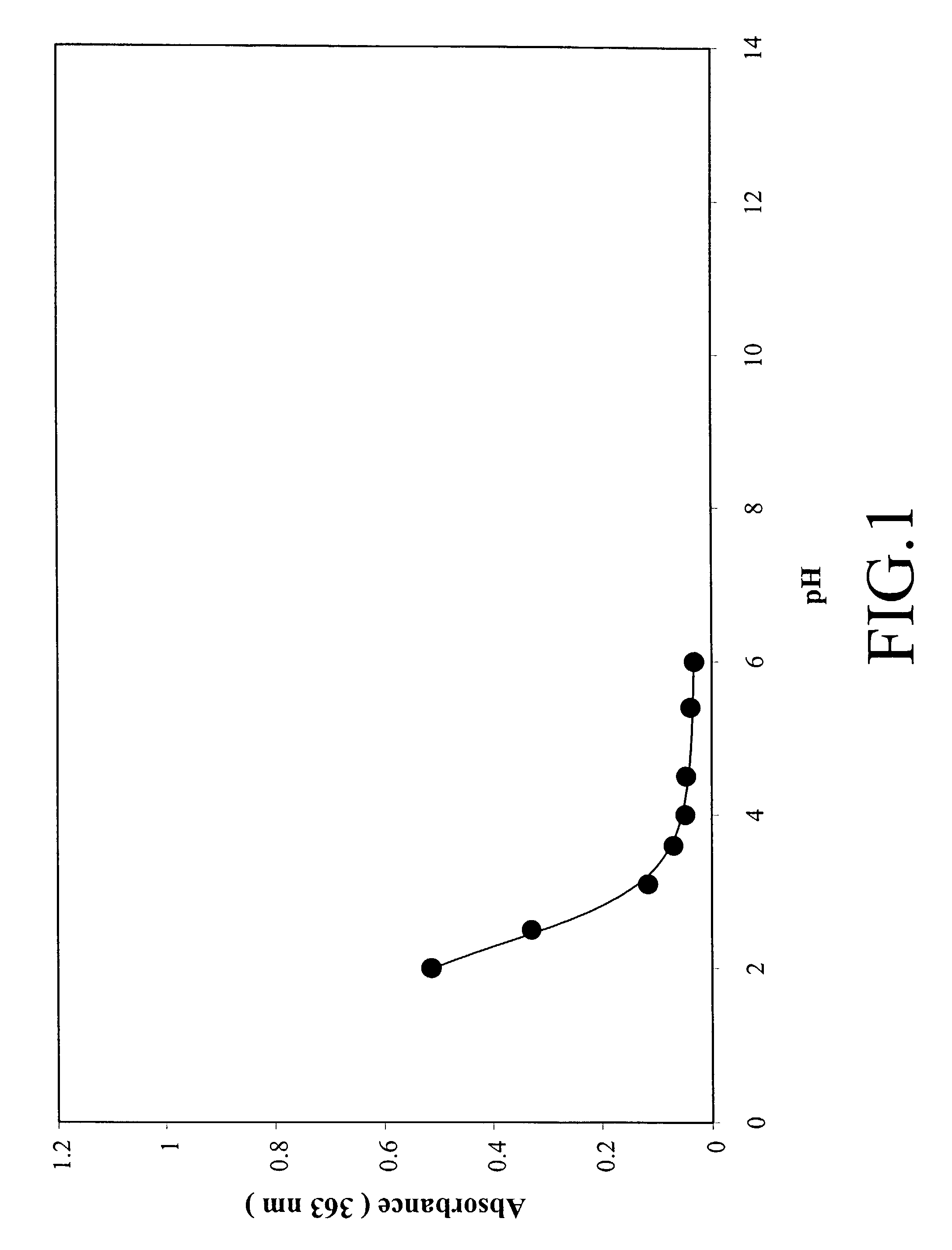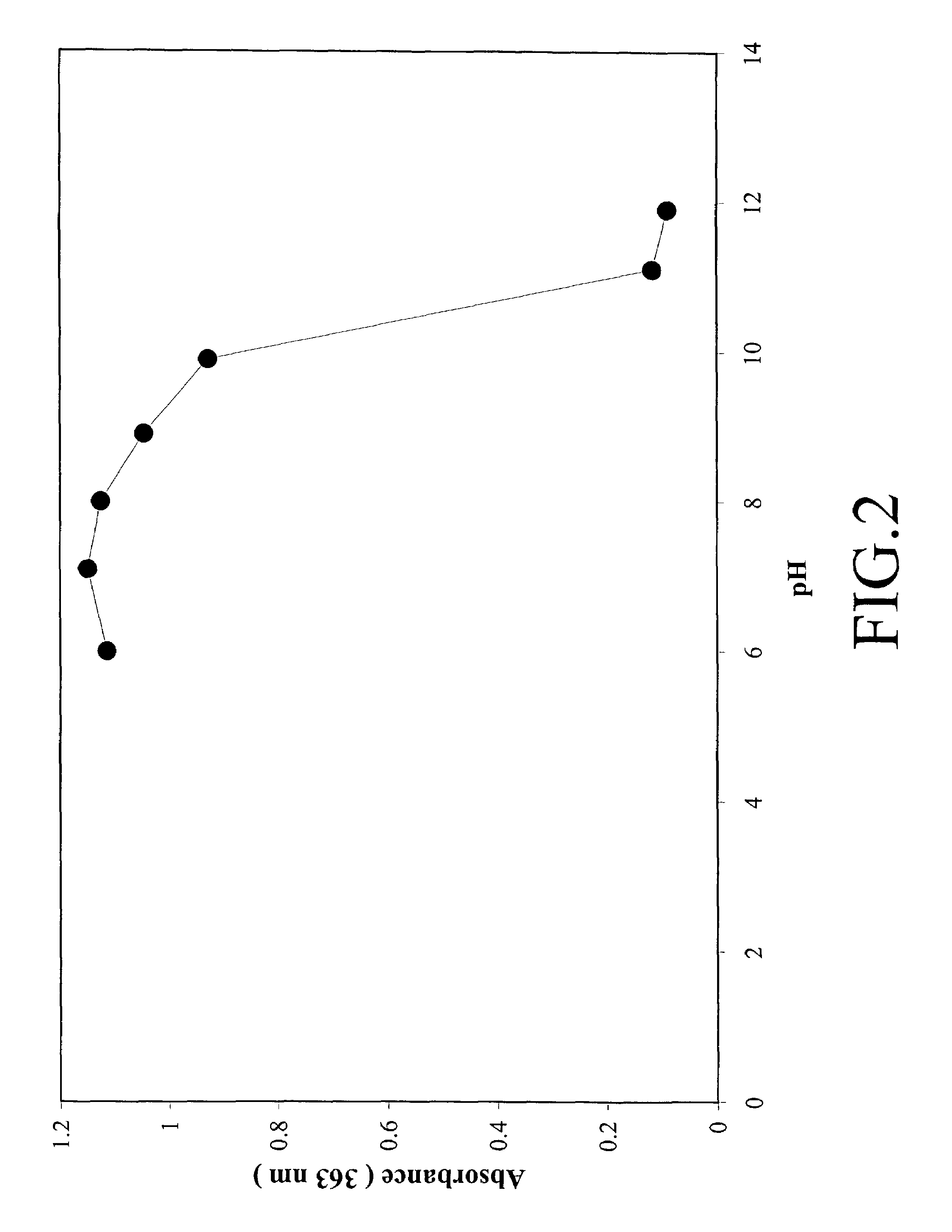Applications of acridinium compounds and derivatives in homogeneous assays
- Summary
- Abstract
- Description
- Claims
- Application Information
AI Technical Summary
Problems solved by technology
Method used
Image
Examples
example 1
[0107]This example describes the syntheses of the electron rich acridinium ester, 2,7-dimethoxy-DMAE and its hapten conjugates. Therein, 2,7-dimethoxy acridine-9-carboxylic acid was synthesized using the procedure described in Zomer at al., “Synthesis, Chemiluminescence, and Stability of Acridinium Ester Labeled Compounds”, Pract. Spectroc. (Lumin. Tech. Biochem. Anal.), vol. 12, pages 505-511 (1991), and condensed with 4-carboxybenzyl-2,6-dimethylphenol. The resulting acridine ester was N-methylated with methyl triflate. Removal of the benzyl ester protecting group exposed the carboxylic acid. The subsequent formation of the valproate, carbamazepine and theophylline conjugates was accomplished via the active NHS ester.
(a) Synthesis of 2,7-dimethoxy-2′,6′-dimethyl-4′-benzyloxycarbonylphenyl acridine-9-carboxylate
[0108]2,7-Dimethoxyacridine-9-carboxylic acid (0.5 g, 0.177 mmol) in anhydrous pyridine (25 mL) was cooled in an ice bath under a nitrogen atmosphere and treated with p-tolu...
example 2
(a) Synthesis of 2-CME-7-methoxy-DMAE
[0119]The synthesis of 2-CME-7-methoxy-DMAE was accomplished from 5-methoxyisatin and 4-bromophenol. N-Alkylation of the sodium salt of 5-methoxyisatin with 4-benzyloxybromobenzene followed by rearrangement in hot alkali afforded the functionalized acridine carboxylic acid which was condensed with 4-nitro-2,6-dimethyl phenol. The benzyl ether in the resulting acridine ester was first cleaved off and the free hydroxyl group was alkylated with benzyl bromoacetate. Methylation of the acridine nitrogen with methyl triflate followed by conversion of the benzyl ester to the free acid completed the synthesis. The acridinium compound was converted to the valproate conjugate via the NHS ester.
(b) Synthesis of 4-benzyloxybromobenzene
[0120]4-Bromophenol (2 g, 0.0116 mol) in acetone (40 mL) was treated with potassium carbonate anhydrous (1.91 g, 1.2 equivalents) and benzyl bromide (1.44 mL, 1.05 equivalents). The reaction was refluxed under a nitrogen atmosp...
example 3
pH Titrations of Acridinium Derivatives
[0131]This example details how the data in FIGS. 1 and 2 were obtained. FIGS. 1 and 2 illustrate how the acridinium to pseudo-base transition is effected as a function of pH by the placement of methoxy groups on the acridinium ester.
[0132]A typical protocol as illustrated for 2,7-dimethoxy-DMAE is as follows. A solution of 2,7-dimethoxy-DMAE (0.5 mg / mL in DMF) was prepared and 20 uL of this solution was diluted with 100 uL of 25 mM phosphate buffer of the appropriate pH and 80 uL of DMF. The solution was allowed to incubate at room temperature for 1.5-2 hours and then the UV spectrum was recorded using a Beckman model DU 7500 spectrophotometer. A 0.1 mL quartz mini-cell was used for the measurements. For each pH, the entire UV spectrum from 220-500 nm was recorded. The intensity of the absorption band of the acridinium chromophore varied with various acridinium derivatives. For 2,7-dimethoxy-DMAE this band was observed at 410 nm whereas for acr...
PUM
 Login to View More
Login to View More Abstract
Description
Claims
Application Information
 Login to View More
Login to View More - R&D
- Intellectual Property
- Life Sciences
- Materials
- Tech Scout
- Unparalleled Data Quality
- Higher Quality Content
- 60% Fewer Hallucinations
Browse by: Latest US Patents, China's latest patents, Technical Efficacy Thesaurus, Application Domain, Technology Topic, Popular Technical Reports.
© 2025 PatSnap. All rights reserved.Legal|Privacy policy|Modern Slavery Act Transparency Statement|Sitemap|About US| Contact US: help@patsnap.com



